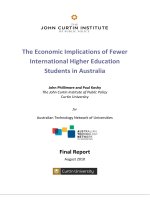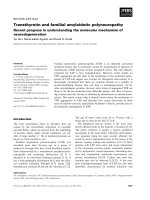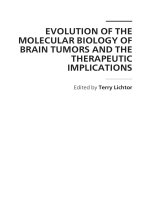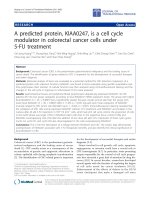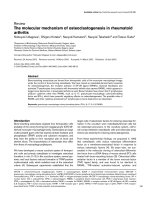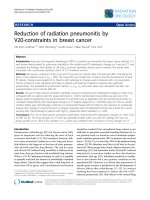Investigating the molecular mechanism of ERp29 regulated cell cycle arrest in breast cancer
Bạn đang xem bản rút gọn của tài liệu. Xem và tải ngay bản đầy đủ của tài liệu tại đây (1.29 MB, 89 trang )
Investigating the Molecular Mechanism of ERp29-regulated
Cell Cycle Arrest in Breast Cancer
Gao Danmei
(B.Sc.)
A THESIS SUBMITTED
FOR THE DEGREE OF MASTER OF SCIENCE
DEPARTMENT OF PATHOLOGY
YONG LOO LIN SCHOOL OF MEDICINE
NATIONAL UNIVERSITY OF SINGAPORE
2011
Acknowledgements
This thesis will not have been completed without the many guidance and warm regards from my
supervisor, my colleagues and my family.
I want to thank my current supervisor, A/P Evelyn Koay, for her constant encouragement and kind
motherly heart that accompanied me to go through the toughest days from July 2010. Also I want
to thank her for the warmest guidance for the thesis writing in the last year of my study.
I also want to thank my previous supervisor, Dr.Zhang Daohai, who offered me the academic
advice during my study. I am grateful for his kindest help on many issues during the first two
years in Singapore. Without his help I would not have complete my study.
I am also thankful to my colleagues who helped me a lot during my study. Especially, I want to
thank Mr. Leong Sai Mun and Ms. Wong Lee Lee, for the kindest help and guidance during the
thesis writing period. Without their kind help I would not have finished my thesis.
I also want to thank my family, my father and mother who were always by my side to support me
in this journey of master study.
Last but not least, I want to thank god for his grace which accompanied me all the way through.
i
Publications
Gao D, Bambang IF, Putti TC, Lee Y K, Richardson DR, Zhang D. ERp29 induces Breast Cancer
cell growth arrest and survival through modulation of activation of P38 and upregulation of ER
stress protein P58 (IPK) Laboratory Investigation advance online publication 7 November 2011;
doi: 10.1038/labinvest.2011.163
ii
TABLE OF CONTENTS
ACKNOWLEDGEMENTS
I
PUBLICATIONS
II
TABLE OF CONTENTS
III
SUMMARY
V
LIST OF TABLES
VI
LIST OF FIGURES
VII
LIST OF ABBREVIATIONS
VIII
CHAPTER1 INTRODUCTION
1.1 Breast cancer
1.1.1 Definition of breast cancer
1.1.2 Incidence of breast cancer worldwide
1.1.3 Incidence of breast cancer in Singapore
1.1.4 Risk factors of breast cancer
1.1.5 Stages of breast cancer
1.1.6 Treatment of breast cancer
1.2 Endoplasmic Reticulum stress and unfolded protein response
1.2.1 Structure and function of the endoplasmic reticulum
1.2.2 Definition of ER stress
1.2.3 Unfolded protein response(UPR)
1.2.4 Unfolded protein response in cancer
1.2.5 eIF2α
1.3 ERp29
1.3.1 Structure and function
1.3.2 Role of ERp29 in carcinogenesis
1.4 Regulation of cell cycle
1.5Hypothesis
1
1
1
2
3
4
5
7
7
8
9
10
12
13
13
14
15
16
CHAPTER 2 MATERIALS AND METHODS
2.1 Materials
2.1.1 Antibodies
2.1.2 Cell lines
2.2 Methods
17
17
18
18
iii
2.2.1 Cell culture
2.2.2 ERp29 expression vector construction
2.2.3 Production of ERp29-overexpressing single stable clone in MDA-MB-231
breast cancer cell
2.2.4 Buffer preparation
2.2.4.1 1X SDS electrophoresis running buffer
2.2.4.2 1X Western blot transfer buffer
2.2.4.3 RIPA(Radio-Immunoprecipitation Assay) buffer
2.2.5 Casting of denaturing polyacrylamide gels
2.2.5.1 Compositions for the 10% and 12% resolving gel
2.2.5.2 Compositions for the 4% stacking gel
2.2.6 Western blotting
2.2.6.1 Total cell lysates
2.2.6.2 Protein concentration measurement
2.2.6.3 Running a SDS-PAGE gel
2.2.6.4 Transfer proteins to PVDF membrane
2.2.6.5 Antibody Hybridization
2.2.6.6 Signal detection
2.2.7 Immunofluorescence and confocal microscopy
2.2.8 siRNA treatment
2.2.9 Statistical method
18
19
19
20
20
20
20
21
21
21
21
21
21
22
22
22
23
23
24
24
CHAPTER 3 RESULTS
3.1 ERp29 regulates transcription factor eIF2α and Nrf2 in ER stress signaling
25
3.2 ERp29 overexpression regulates cell cycle mediators and inhibitions in breast cancer 30
3.3 ERp29 regulates cellular localization of the cell cycle regulator cyclinD1
34
39
3.4 ERp29 up-regulates ER stress induced molecular chaperone p58ipk
CHAPTER 4 DISCUSSION
42
FUTURE WORK
48
CONCLUSION
50
REFERENCES
52
APPENDIX 1
57
APPENDIX 2
59
iv
Summary
Endoplasmic reticulum protein 29 (ERp29) is a novel endoplasmic reticulum (ER) luminal
protein and plays a critical role in protein unfolding and secretion. Recently, it was found that
ERp29 is a novel tumor suppressor which drives the proliferative MDA-MB-231 breast cancer
cells into a dormant state. However, the mechanism underlining this process is not fully
understood. In this thesis, some aspects of the mechanism of how ERp29 induces tumor cell
dormancy are studied. These studies provided evidence that overexpression of ERp29 induces
breast cancer cell cycle arrest by modulating endoplasmic reticulum stress.
Overexpression of
ERp29 down-regulates the expression of eIF2, a key ER transcription factor, and up-regulates
the cyclin-dependent kinase, p27kip1, a tumor suppressor. High expression of eIF2 was found in
three proliferative breast cancer cell lines -- BT549, MDA-MB-231 and SKBR3, suggesting its
potential as a marker of tumor aggressiveness. P58ipk was also markedly increased, and appeared
to inhibit eIF2 phosphorylation. Silencing of eIF2 in ERp29-overexpressed MDA-MB-231
cells dramatically induces up-regulation of p27kip1. Data showed that the downstream target of
eIF2, cyclinD1, translocated into the cytoplasm of the ERp29-overexpressed MDA-MB-231
cells, in contrast to the accumulation of cyclinD1 inside the cell nuclei, in ERp29-silenced MCF7
cells. Using immunofluorescence imaging, the translocation of cyclinD1 into the cytoplasm was
shown to be phosphorylation-dependent, as phosphorylated cyclinD1 also translocated to the
cytoplasm in the ERp29-overexpressed MDA-MB-231 while in the ERp29-silenced MCF7,
phosphorylated cyclinD1 accumulated inside the nuclei, which facilitates tumor growth.
v
List of Tables
Table 1 Staging of Breast Cancer
Table 2 Treatment of breast cancer
Table 3 UPR in tumor development
Table 4 Antibodies used in this study
vi
List of Figures
Figure 1. Incidence of breast cancer world wide
Figure 2. Structure of Endoplasmic Reticulum
Figure 3. Signal transduction of unfolded protein response.
Figure 4.ERp29 expression down-regulates translation initiation factor eIF2α.
Figure 5. Expression of eIF2α in breast cancer cell lines.
Figure 6.Expression of Nrf2 in breast cancer cell lines.
Figure 7. Expression of Nrf2 in ERp29 overexpressing MB231 or ERp29 silenced MCF7.
Figure 8. Expression of Nrf2 in ERp29 silenced MB231(A3).
Figure 9. Expression level of important cell cycle regulators.
Figure 10. ERp29 regulates CDK inhibitors.
Figure 11. ERp29 regulates G1 cyclins in MDA-MB-231 and MCF7.
Figure 12. Silencing of eIF2α up-regulates p27 expression.
Figure 13. ERp29 modulates ER stress signaling.
Figure 14. ERp29 regulates cyclinD1/2 subcellular localization in MDA-MB-231 cells
Figure 15. ERp29 regulates cyclinD1/2 subcellular localization in MCF7 cells
Figure 16. ERp29 regulates cyclinD1 nuclear export in MDA-MB-231 cells
Figure 17. ERp29 regulates cyclinD1 nuclear export in MCF7 cells
Figure 18. Schematics showing the molecular players involved in ERp29-induced signaling
for tumor dormancy.
vii
List of Abbreviations
APS
ATF4
ATF6
BSA
CDK
CHOP
DAPI
DTT
EDTA
eIF2α
ER
ERp29
FBS
GRP78
GRP94
HRP
IRE1
Nrf2
PBS
PBST
PDI
p-eIF2α
PERK
PVDF
Rb
RIPA
rER
SDS
SDS-PAGE
sER
SiRNA
SR
SRP
TEMED
UPR
XBP-1
Ammonium persulfate
Activating transcription factor 4
Activating transcription factor 6
Bovine serum albumin
Cyclin-dependent kinase
C/EBP homologous protein
4'-6-Diamidino-2-phenylindole
Dithiothreitol
Ethylenediaminetetraacetic acid
eukaryotic translation initiation factor 2-α subunit
Endoplasmic reticulum
Endoplasmic reticulum protein 29
Fetal bovine serum
Glucose-regulated protein 78
Glucose-regulated protein 94
Horseradish peroxidase
Inositol-requiring enzyme 1
NF-E2 related factor 2
Phosphate buffered saline
Phosphate buffered saline with Tween-20
Protein disulfide isomerase
Phosphorylated-eIF2α
PKR-like endoplasmic reticulum kinase
Hybond-P Polyvinylidene Fluoride
Retinoblastoma
Radio-Immunoprecipitation Assay
Rough endoplasmic reticulum
Sodium dodecyl sulfate
Sodium dodecyl sulfate polyacrylamide gel electrophoresis
Smooth endoplasmic reticulum
Small RNA
Sarcoplasmic reticulum
Signal recognition particles
N,N,N,N -tetramethyl-ethylenediamine
Unfolded Protein Response
X-Box binding protein 1
viii
Chapter 1
INTRODUCTION
1.1 Breast Cancer
1.1.1
Definition of Breast Cancer
Normal cells reproduce themselves in a healthy way because of proper regulatory
functions of certain genes inside their nuclei. However, if mutation occurs, some of these
genes will be turned on while others will be turned off; leading to cells that growing and
dividing without regulatory control and thus forming a tumor. A tumor can be benign, that is
not harmful to health, or it can be malignant, resulting in growth out of control and spread
across the whole body. Breast cancer,-refers to the malignant cancer that originates from
breast cells. Breast cancer mostly originates in the cells of lobules or ducts. Cancers
originating from ducts are known as ductal carcinomas; those originating from lobules are
known as lobular carcinomas. It can also originate at a lesser frequency, from stromal tissues,
which include the fatty and fibrous connective tissues of the breast.
1.1.2
Incidence of Breast Cancer Worldwide
Breast cancer is the most common cancer among women world-wide (1).In the
more-developped countries, the breast cancer incidences are the highest (2). In 2002, It was
estimated that 636,000 new cases occurred in developed countries and 514,000 more
occurred in developing countries (1). Breast cancer is also the most important cause of
neoplastic deaths among women; the estimated number of deaths in 2002 was 410,000
world-wide (1). The incidence of breast cancer is low (less than 0.02%) in most countries
1
from sub-Saharan Africa, in China and in other countries of eastern Asia, except Japan. The
highest rates (0.08%-0.09%) are recorded in North America, in regions of South America,
including Brazil and Argentina, in northern and western Europe, and Australia. (Figure 1) In
rural areas, the rate of breast cancer is lower than the unban areas (2).
Figure 1 Incidence of breast cancer world-wide.
Data is sourced from World Cancer Report 2008, International Agency for Research on Cancer
1.1.3
Incidence of Breast Cancer in Singapore
Breast cancer is the most common cancer among Asian women (3) and among Singapore
women (4). During 2005 to 2009, breast cancer was the top number 1 cancer with the highest
incidence among Singapore women (Figure 2) (5). It was also the number 1 cancer resulting
in death among females in Singapore.During the past four decades, since 1968, when
Singapore experienced rapid economic growth and transited from a developing country to a
developed industrial society, the breast cancer incidence grews steadily (6)
2
Figure 2: Ten Most Frequent Cancers in Singapore Females (%), 2005 – 2009
Data were obtained from the Singapore Cancer Registry Interim Annual Registry Report
Trends in Cancer Incidence in Singapore 2005-2009 (5)
1.1.4
Risk factors of breast cancer
A wide range of genetic or life-style related factors may increase the risk of having breast
cancer. Firstly, gender, age, and family history may play an important role. Most
fundamentally, being a woman means that the chance of getting breast cancer is much higher
as compared to being a man. Also, if a woman is older than 50 years of age or has a close
relative with breast cancer, then her chance of getting breast cancer increases significantly (7).
Exposure to the hormones such as estrogen and progesterone may also lead to breast cancer.
Therefore, women with longer menstral periods (due to earlier onset of menstruation or later
age of menopause) may suffer a higher risk of breast cancer. Similarly, combined hormone
therapy involving both estrogen and progesterone exposes the subjects to greater risk of
having breast cancer at a more advanced stage(8). Interestingly, women who never got
pregnant or are pregnant at a later age (after 30 years old) are also at a higher risk of getting
3
breast cancer. On the contrary, multiple pregnancies at a younger age (below 30 years old)
reduce breast cancer risk(9).
In order to lower the risk of having breast cancer, keeping a healthy life style is important.
For example, consumption of alcoholic drinks increases the risk of having breast cancer (7).
Having no more than one cup of alcoholic drink per day is thus recommended to avoid
getting the disease. Watching one’s weight is important as well, since obese women are at
greater risk of getting breast cancer (7).
1.1.5
Stages of Breast Cancer
Table 1 Staging of Breast Cancer.
Adapted from />Stages
Definition
Stage 0
Cell grows abnormally but not invasive. For example, Ductal Carcinoma In Situ or
Lobular Carcinoma In Situ
Stage I
breast cancer. Cancer cells have invaded breast tissue beyond the original place of
breast. The tumor is no more than 2 centimeters across.
Stage II
The tumor is no more than 2 centimeters across. The tumor cell has spread to the
lymph nodes under the arm.
or
The tumor is between 2 and 5 centimeters. But has not spread to the lymph nodes
under the arm.
or
The tumor size is between 2 and 5 centimeters. And has spread to the lymph nodes
under the arm.
or
The tumor is larger than 5 centimeters. But has not spread to the lymph nodes under
the arm.
Stage IIIA
The tumor is no more than 5 centimeters across. And has spread to underarm lymph
nodes that are attached to each other or to other structures. Or the cancer may have
spread to lymph nodes behind the breastbone
or
The tumor is more than 5 centimeters across. The cancer has spread to underarm
lymph nodes that are either alone or attached to each other or to other structures. Or
4
the cancer may have spread to lymph nodes behind the breastbone.
Stage IIIB
A tumor of any size that has grown into the chest wall or the skin of the breast. It may
be associated with swelling of the breast or with nodules (lumps) in the breast skin:
The cancer may have spread to lymph nodes under the arm.
or
The cancer may have spread to underarm lymph nodes that are attached to each
other or other structures. Or the cancer may have spread to lymph nodes behind the
breastbone.
Or
Inflammatory breast cancer is a rare type of breast cancer. The breast looks red and
swollen because cancer cells block the lymph vessels in the skin of the breast. When
a doctor diagnoses inflammatory breast cancer, it is at least Stage IIIB, but it could
be more advanced.
Stage IIIC
A tumor of any size. It has spread in one of the following ways:
The cancer has spread to the lymph nodes behind the breastbone and under the arm.
Or
The tumor cell has spread to the lymph nodes above or below the collarbone.
Stage IV
1.1.6
The cancer has spread to other organs, such as the bones or liver.
Treatment of Breast Cancer
There are many treatment options that women with breast cancer can choose from. The
most common one is surgery, which may include removing only cancerous tissue or the
whole breast together with some lymph node. Surgery that removes only the cancerous tissue
is a lumpectomy or a segmental mastectomy. Surgery that removes the whole breast is called
mastectomy. Stage 0 breast cancer can be cured by lumpectomy while stage 1 or stage 2 may
need a mastectomy. Besides surgery, there are other options including radiation therapy,
hormone therapy, chemotherapy, and targeted therapy. Surgery is often combined with other
treatment such as radiation therapy or chemotherapy. Surgery and radiation therapy are types
of local therapy. They remove or destroy cancer cells within the breast. Hormone therapy,
chemotherapy, and targeted therapy are types of systemic therapy. The drug enters the
bloodstream and destroys or controls cancer throughout the body. For stage 4 metastatic
5
cancer, surgery, radiation therapy, chemotherapy, and targeted therapies are combined to
manage the disease.
Table 2 Treatment of breast cancer.
Content was sourced from on 28 Mar 2011
Therapy
Surgery
Descriptions
Types of surgery
Description
Lumpectomy
(breast-conserving
surgery)
Removal of only the tumor and a small amount of surrounding
tissue.
Mastectomy
Removal of all of the breast tissue
Prophylactic
mastectomy
Preventive removal of the breast to lower the risk of breast
cancer in high-risk people.
Prophylactic ovary
removal
A preventive surgery that lowers the amount of estrogen in the
body
Cryotherapy, also
called cryosurgery,
uses extreme cold to
freeze
and
kill
cancer cells
Uses extreme cold to freeze and kill cancer cells
Chemotherapy
A systemic therapy that uses medicine to go through the blood system to weaken and
destroy breast cancer cells in the whole body
Radiation
therapy
A highly targeted, highly effective way to destroy cancer cells that may stick around
after surgery. It can reduce the risk of breast cancer recurrence by about 70%. It is
relatively easy to tolerate and its side effects are limited to the treated area.
Hormonal
therapy
Medicines treat hormone-receptor-positive breast cancers in two ways: by lowering the
amount of the hormone estrogen in the body and by blocking the action of estrogen on
breast cancer cells. It can also be used to help shrink or slow the growth of
advanced-stage or metastatic hormone-receptor-positive breast cancers
Targeted
Therapies
Types
Description
Herceptin
Works against HER2-positive breast cancers by blocking the
ability of the cancer cells to receive growth signals
Tykerb
Works against HER2-positive breast cancers by blocking certain
proteins that can cause uncontrolled cell growth.
Avastin
Works by blocking the growth of new blood vessels that cancer
cells depend on to grow and function.
6
1.2 Endoplasmic Reticulum Stress and Unfolded Protein Response
1.2.1. Structure and function of the endoplasmic reticulum
The endoplasmic reticulum (ER) is a membranous organelle in eukaryotic cells that is a
single compartment (10). Structurally distinct domains of this organelle include the nuclear
envelope (NE), the rough ER (rER) and the smooth ER (sER) (Figure 2) and the regions that
contact other organelles (11). The morphology of ER may not be homogenous but may differ
in different cell types or may have different functions. The two subregions of the ER, both
rough and smooth, are visually distinct. This may be because they contain different
membrane proteins (10). The rough ER, with ribosomes on its surface, is the place where
translation of a secretoty protein or a membrane protein and the cotranslational translocation
across the ER membrane occurs. It contains signal recognition particles (SRP) which
recognize newly synthesised polypeptide from the membrane-bound ribosome. The
ribosome-SRP complex together with the nascent polypeptide is targeted to the ER membrane
by interaction with the heterotrimeric SRP receptor. As translocation proceeds, the nacent
polypeptide is translocated across the ER membrane via the macromolecular machinery
called a translocon. Because protein translocation is important for all the eukaryotic cells,
they all have rER. In contrast, sER only exists in certain cell types, including
steroid-synthesizing cells, liver cells, neurons, and muscle cells. The primary activities of the
sER are very different in each of these cell types. For example, in liver cells, the sER is
important for detoxification of hydrophobic substances. In steroid-producing cells, it is the
site of many of the synthesis steps. In muscle cells, it is called sarcoplasmic reticulum (SR)
7
and is primarily involved in calcium release and uptake for muscle contraction and in neurons,
although less well established; it is also probably required for calcium handling. Thus, the
sER is also a cell type-specific suborganelle of the ER.
Figure 3 Structure of Endoplasmic Reticulum.
The picture is sourced from
on December 21, 2011
1.2.2. Definition of ER Stress
The ER is a primary place where secretory proteins or membrane proteins are
synthesized (11).During this process, newly synthesized proteins are folded into proper
conformation and undergo post translational modifications such as N-linked glycosylation
and disulfide bond formation (12). For maintaining the diverse functions of the newly
synthesized protein, it is very important that the nascent polypeptide is properly folded to
become a mature protein. The ER provides stringent quality control systems to ensure that
only correctly folded proteins exit the ER and unfolded or misfolded proteins are retained and
ultimately degraded (13). If the influx of nascent, unfolded polypeptides exceeds the folding
8
and/or processing capacity of the ER, unfolded protein accumulate inside the ER lumen, and
the normal physiological state of the ER is perturbed. This situation is termed ER stress.
1.2.3. Unfolded Protein Response (UPR)
When the ER suffers from ER stress, a signaling pathway called unfolded protein
response (UPR) is activated to return the ER to its normal physiological conditions. This
signal pathway down-regulates nascent poly-peptides entering the ER and up-regulates
molecular chaperones to increase the folding ability of the ER (12). Also, transcription of
genes encoding secretory proteins and translation of secretory proteins are brought down, and
clearance of misfolded proteins are increased (14). There are mainly three transducers
involved in the signal transduction of the UPR, namely IRE1,ATF6, and PERK (14). Firstly,
the unfolded protein binds to the luminal domain of IRE1, triggers its autophosphorylation
and oligomerization. It then endonucleolytically cleaves its substrate X-box binding
protein-1(XBP-1) mRNA. The spliced mRNA is then ligated and encodes an activator of
UPR target genes. Secondly, the activation of ATF6 leads to its transportation from the ER to
the Golgi apparatus, and its cleavage by the Golgi-resident proteases S1P and S2P. After the
cleavage, a cytosolic DNA-binding portion is released to enter the nucleus to activate gene
expression. Thirdly, PERK also contains a protein kinase domain which undergoes
autophosphorylation and oligomerization. Its activation phosphorylates its downstream target
-the eukaryotic translation initiation factor 2-α subunit (eIF2α). This leads to the global
translation shut down and thus prevents newly synthesized protein localization in the ER.
Also, the phosphorylation of eIF2α activates a transcription factor ATF4 to activate more
9
UPR target genes (Figure 4).
Figure 4 Signal transduction of unfolded protein response.
The picture is sourced from X Shen et al The unfolded protein response—a stress signaling pathway of the
endoplasmic reticulum J Chem Neuroanat. 2004 Sep;28(1-2):79-92.
1.2.4 Unfolded Protein Response in Cancer
Solid tumors are continuously challenged by a restricted supply of nutrients and oxygen
due to insufficient vascularisation. Therefore, the stress conditions such as hypoxia, nutrient
deprivation and pH changes, activate the UPR pathway. The UPR is a cytoprotective pathway
but prolonged activation of UPR can lead to apoptosis (15). Under the conditions related to
cancer formation, the role of the UPR in tumor development is ambiguous (16). The recent
researches focused on this are summarized in Table 3. Brifely, on the one hand, some
components of UPR, such as PERK, GRP78, and ATF4 are activated during cancer genesis to
10
promote tumor survival (17) .Tumor cell survival is achieved by adapting the tumor cells to
hypoxia and facilitating angiogenesis (18) or by increased expression of growth factors in
tumor cells (19). One essential transcription factor in the UPR pathway, the XBP1, has been
demonstrated to be necessary for cancer cell survival under hypoxia (20). The other
component, GRP78, has also been proven to be critical for tumor cells to grow (21).
Nevertheless, the expression level of GRP78 is shown to be significantly correlated with
cancer reccurence and survival, with the high expression linked to higher reccurence and
more death (22).
On the other hand, activation of these molecules- PERK, eIF2α, GRP78 are reported to
induce cell cycle arrest and as such suppress cancer cell growth (23) (24) For GRP78 and
PERK, the role in cancer development is ambiguous, and awaiting further clarification.
Table 3 Unfolded Protein Response(UPR) in tumor development
Year
Author
Components of UPR
Study
Role
2006
D.R. Fels, et al.
PERK
eIF2α
ATF4
The
PERK/eIF2a/ATF4
axis adapts tumor cell
to hypoxia stress
Pro-survival
2006
J.D. Blais, et al.
PERK
PERK-dependent
translational regulation
promotes tumor cell
adaptation and
angiogenesis in
response to hypoxic
stress
Pro-survival
1999
J.W. Brewer, et
al.
eIF2α
Translational arrest
induced via eIF2α
phosphorylation causes
cell cycle arrest
Tumor suppresive
2004
D.J. Perkins,et al.
eIF2α
Defects in translational
regulation mediated by
the eIF2α inhibit
Facilitaes malignant
transformation
11
antiviral activity and
facilitate the malignant
transformation of
human fibroblasts
2007
B.Drogat,et al.
IRE1
IRE1 signaling Is
essential for
ischemia-induced
vascular endothelial
growth factor-a
expression and
contributes to
angiogenesis and
tumor growth in vivo
Contributes to
angiogenesis and
tumor growth
2004
L.
Romero-Ramirez,
et al.
XBP-1
XBP1 is essential for
survival under hypoxic
conditions and is
required for tumor
growth
Pro-survival
2007
A.S. Lee,et al.
GRP78
GRP78 is highly
expressed in tumors
Pro-survival
1996
C.Jamora,et al.
GRP78
Knock-down of
GRP78 inhibits tumor
progression
Promotes tumor
progression
2006
C. Denoyelle,et
al.
GRP78
ER stress upregulates
UPR to inhibit tumor
growth
Tumor suppression
1.2.5 eIF2α
UPR activation can be mediated by three major signal transduction pathways, one of
which includes activation of the eukaryotic initiation factor 2 α subunit(eIF2α). eIF2 is a
multimeric protein which binds to GTP and initiator methionyl-tRNAi (Met-tRNAi), and
mediates the association of Met-tRNAi to the 40s ribosomal subunit (25). It consists of three
subunits α, β and γ. The α subunit, named eIF2α, has a phosphorylation unit at the Ser51
position and its phosphorylation by PERK shuts off general translation to protect cells from
12
ER stress (26). Meanwhile, EIF2α is a key translation initiation factor that regulates the rate
of protein synthesis during cell proliferation. Overexpression of eIF2α is frequently found in
tumors. For instance, expression of eIF2α was found to be positively correlated with
classification of lymphoma behavior (27). A significantly increased expression of eIF2α in
aggressive thyroid carcinoma exists compared to conventional papillary carcinoma (28).
Expression of eIF2α was increased markedly in both benign and malignant neoplasms of
melanocytes and colonic epithelium (29). Generally, eIF2α expression may have a strong
linkage with tumor cell aggressiveness.
1.3 ERp29
1.3.1 Structure and Function
ERp29 was first isolated and its cDNA cloned from rat enamel cells (30) and rat liver
cells (31). Tissue expression of ERp29 was examined by immunoblotting (32) and northern
blotting (31). Its expression was detected in all the tissues (32). A topology study identified
ERp29 as an ER luminal protein known as reticuloplasmin. It was subsequently identified as
a reticuloplasmin with an ER-retention motif, KEEL, present at the carboxyl-terminus (30).
However, unlike other reticuloplasmins, it lacks the calcium-binding motifs and does not
contain glycosylation sites. Moreover, it is highly homologous with members of the protein
disulfide isomerase family, but lacks the thioredoxin-like (cys-X-X-cys) catalytic moieties
that distinguish this class of reticuloplasmins (30). It exists mainly as a dimer and may also
be involved in some higher-order homo- and/or heterocomplexes (33). Further research
indicated that ERp29 is a constitutively expressed housekeeping gene which is conserved in
all mammals (34).
13
Under ER stress, ERp29 is drastically induced like other reticuloplasmins such as GRP78
and GRP94. ERp29 was found to interact with the ER chaperone BiP/GRP78 (31). Two-fold
higher levels of ERp29 were observed during the secretion of enamel proteins from the cells.
After this period, ERp29 was down-regulated (32). These results corroborate that ERp29 may
have an essential role in secretory-protein synthesis.
In order to further explore the function of ERp29, an ERp29-overexpressed FRTL-5 cell
line was established. The overexpressed ERp29 was observed to be concentrated in the ER
microsome. Moreover, overexpression of ERp29 resulted in enhancement of thyroglobulin
(Tg) secretion.
On the contrary, ERp29 silencing attenuates Tg secretion (35). The overexpression of
ERp29 can also induce the expression of ER chaperones such as GRP94, Calnexin, BiP,
ERp72, PDI and PERK (36). The interaction of ERp29 with other ER chaperones (GRP94,
Calnexin, BiP ERp72) and PERK was also observed.
Overall, these findings serve to highlight the important role of ERp29 in the secretion of
proteins from the ER.
1.3.2 Role of ERp29 in carcinogenesis
As a novel ER chaperone, the role of ERp29 in carcinogenesis is currently ambiguous.
Firstly, ERp29 is found to be intensively expressed in infiltrating basal-cell carcinoma of the
skin (37). Secondly, in a recent study, endogenous ERp29 was up-regulated in xenografts of
MCF7 cells compared to in vitro cultured MCF7 cells. In order to further the studies, MCF-7
cell line overexpressing wild-type or dominant-negative ERp29 were constructed, along with
14
the mock-transfect cell line as a control. These three cell lines grew at a similar rate in vitro.
However, xenografts expressing a dominant-negative ERp29 grew significantly less than the
tumors from the mock-transfected cell line or cells expressing wild-type ERp29. In addition,
morphological examination showed that tumors from wild-type ERp29 overexpressing cells
had a more aggressive pattern as compared to tumors derived from the mock-transfected or
ERp29-dominant negatively expressing cells. In this study, the results seem to indicate that
ERp29 may be involved in tumorigenesis (38).
In contrast, in another recent study, the expression of ERp29 was reduced with tumor
progression. ERp29 overexpression led to cell cycle arrest in G0/G1 phase in the proliferative
MDA-MB-231 breast cancer cell line. Moreover, it also led to a phenotype change and
mesenchymal-epithelial transition. ERp29 overexpression decreased cell migration and
reduced cell transformation.The genes involved in cell proliferation is highly reduced while
those of some tumor suppressor are up-regulated. ERp29 is proven to negatively regulate cell
growth in breast cancer cells (39), while silencing of ERp29 in MCF-7 cells enhanced cell
aggressive behavior.
Overall, the role of ERp29 in carcinogenesis is controversial, and further research is
needed to clarify whether it is an oncogene or a tumor suppressor.
1.4 Regulation of Cell Cycle
Cell cycle is defined as the ordered process that occurs during cell division. In eukaryotic
cells, cell cycle includes four distinctive phases- G1, G2, S and M. During the G1 phase, a
cell synthesizes materials for cell duplication and division, followed by the S phase, in which
15
DNA is synthesized. In the M phase, cell division occurs, leading to cell duplication. The cell
cycle is a well regulated process in which cyclins and cyclin-dependent kinases(CDKs) play
important roles. In the G1 phase, cyclin-D, cyclin-E, as well as cyclin-D- and
cyclin-E-dependent kinases are critical mediators deciding whether the cell will progress
smoothly through this phase.
Cyclin-D1 is a well-studied G1 cyclin that regulates cell cycle progression and cell
growth. Past studies revealed that it is exported from nucleus to cytoplasm during the S phase
(40). Another study demonstrated that its nuclear localization is related to malignant cell
transformation (41). Indeed, in the current study, the cyclinD1 nuclear localization in breast
cancer cells is shown to be regulated by the key molecule-ERp29. More will be discussed in
relation to this phenomenon in the Results and Discussion section
1.5 Hypothesis
The preliminary results in our laboratory suggest that ERp29 induces tumor cell
dormancy in breast cancer, although the molecular mechanism under this process is not fully
elucidated. As overexpression of ERp29 induces ER stress and activates unfolded protein
response, whether the ER stress signaling pathway is involved in ERp29-mediated cell cycle
arrest is still a question. Here in my thesis, we hypothesized that ERp29 induces cell cycle
arrest in breast cancer through the ER stress signaling pathway. The aim of this research is to
clarify what signal molecules in the ER stress signal pathway are regulated by ERp29 and
how cell cycle regulators are modified, leading to cancer cell dormancy.
16
